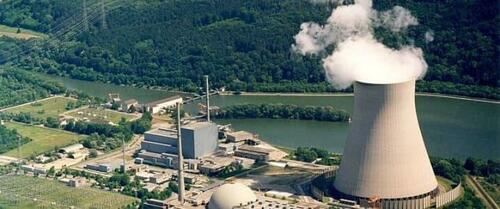In Unexpected Swing, Germany’s Public Now Favors Nuclear Power
Authored by Alex Kimani via OilPrice.com,
-
The energy crisis in Europe has changed the public opinion in Germany on nuclear power.
-
The German Green Party and Social Democrats have long supported a move away from nuclear energy.
-
Nuclear energy is seen as a preferable energy source to a fall back to burning coal.
For decades, Germany has maintained a love-hate relationship with nuclear power. Currently, Germany has three existing nuclear reactors that produce ~6% of the country’s power supply, a far cry from the 1990s when 19 nuclear power plants produced about a third of the country’s electricity supply.
The genesis of the current state of affairs can be traced back to 1998 when a new center-left government consisting of the Greens party and Social Democrats started demanding that the country moves away from nuclear power, a long-held objective of the Greens. The Greens became prominent in the 1980s after they started rallying against the dangers of nuclear energy and nuclear weapons against the backdrop of the Cold War. Indeed, the last new nuclear plants to be built in Germany date back to 2002 after which plans were put in place to phase out all existing plants over the next few decades.
However, the tide turned again in 2010 after a coalition of the liberal Free Democratic Party and the conservative Christian Democrats rose to power and extended the use of nuclear energy in Germany by up to 14 years. But alas, the newfound love for nuclear power was not to last: a year later, explosions and meltdowns at the Fukushima nuclear power plant in Japan soured the public’s mood on nuclear power and forced Germany to do another about-face on this policy. Berlin then returned to the original plan for a nuclear phaseout by the end of 2022.
But Russia’s war in Ukraine is forcing a rethink of energy security not only in Germany but also by the entire continent. Up until last year, Germany and Russia were major energy partners, with the latter providing the country with the majority of its oil and natural gas. But Russia’s war has led to Europe and Germany scrambling for alternative supplies as winter looms. Germany is now rethinking its nuclear phaseout strategy, and the public is falling in line.
“We will need more electric power in the future. That’s a fact. And 6% can be a lot to miss when there is nothing new [to replace it]. We’d be losing 6% when we really will need more,” German Chancellor Olaf Scholz has told Deutsche Welle. Previously, the majority of the public was in favor of the nuclear phaseout in the aftermath of the Fukushima disaster; now over 80% are in favor of extending the lifespan of Germany’s existing nuclear reactors.
Nuclear energy is seen as a preferable energy source to a fall back to burning coal. According to Dutch-based anti-nuclear group WISE, nuclear plants produce 117 grams of CO2 emissions per kilowatt-hour, much lower compared to burning lignite which emits over 1,000 grams of CO2 per kilowatt-hour.
Back To Coal
But limiting greenhouse gas emissions is hardly a top priority for energy-starved Europe. According to a report by the Observer Research Foundation, energy supply disruptions triggered by Russia’s war on Ukraine took LNG prices even higher leaving coal as the only option for dispatchable and affordable power in much of Europe, including the tough markets of Western Europe and North America that have explicit policies to phase out coal.
According to the Washington Post, coal mines and power plants that closed 10 years ago have begun to be repaired in Germany. In what industry observers have dubbed a “spring” for Germany’s coal-fired power plants, the country is expected to burn at least 100,000 tons of coal per month by winter. That’s a big U-turn considering that Germany’s goal had been to phase out all coal-generated electricity by 2038.
Other European countries such as Austria, Poland, the Netherlands and Greece have also started restarting coal plants.
Meanwhile, China’s coal imports have been surging as power generators increased purchases to provide for peak summer electricity demand. China has the largest number of operational coal power plants with 3,037 while Germany, the largest economy in the EU has 63.
The situation has led to soaring global coal consumption that could reach levels we haven’t seen in a decade, though there will be a limit to growth considering that investment in any new coal-powered plants has stalled. But that only makes the coal market tighter, pushing the energy source into an outperforming category.
Thermal coal, which is the variety used to generate power, has seen a 170% rise in price since the end of 2021–most of those gains made following Russia’s invasion of Ukraine.
Tyler Durden
Fri, 01/27/2023 – 02:45
via ZeroHedge News https://ift.tt/3MXg64T Tyler Durden
